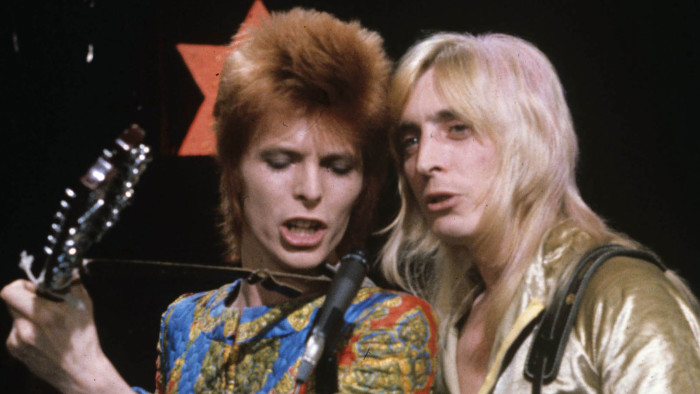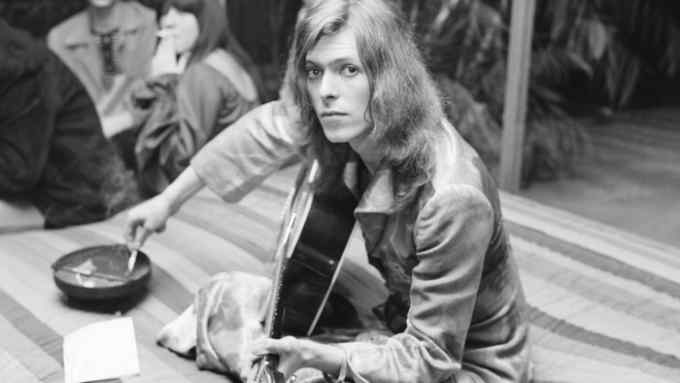David Bowie’s Starman was a moment of awakening

Roula Khalaf, Editor of the FT, selects her favourite stories in this weekly newsletter.
Can a pop song change the world? There are many who claim that when David Bowie performed “Starman” on the BBC’s Top of the Pops on July 6 1972, the earth shifted a little on its axis. Into the dull brown living rooms of Britain was beamed the image of a skinny, slinky young man in a multicoloured jumpsuit strumming a 12-string acoustic guitar and singing in eccentric vowels about the coming of an alien saviour. And when Bowie draped his arm gently around silver-clad, silver-haired guitarist Mick Ronson’s shoulder and pulled him closer to sing the chorus, it’s not hard to imagine a nationwide chorus of disapproving harrumphings and newspaper-rattlings. Bowie periodically fixed his eyes on the camera, addressing the viewer directly: “I had to phone someone so I picked on you-hoo-hoo.” It was electrifying.
Perhaps it’s an oversimplification to reduce cultural history to “moments” but there are certainly plenty of pop stars, fashion designers, artists and writers who claim that Bowie’s striking performance was for them a moment of awakening, a realisation that they were not alone, that there were others who were “other”. Among them is Dylan Jones, editor of the UK edition of GQ magazine, who has written an entire book (When Ziggy Played Guitar) on those fateful few minutes; others include Dave Gahan of Depeche Mode, Marc Almond, Boy George, Holly Johnson, Ian McCulloch, Gary Numan and Neil Tennant.
But if Bowie was strange, the song was far from it: “Starman” was an instant pop classic whose glorious chorus echoed the octave-leaping “Over the Rainbow”. Familiar, too, was the morse-code motif (achieved through a treated synthesis of guitar and piano), signifier of an urgent message and heard earlier on Glen Campbell’s “Wichita Lineman” and on the Supremes’ “You Keep Me Hangin’ On” (Vanilla Fudge’s version of the same song accentuates this device).
Bowie himself had laboured for three years following his 1969 hit “Space Oddity” without much success. “Starman” was his moment; this was his breakthrough.

Over the years various cover versions of “Starman” have been recorded, few of them noteworthy. One exception came from Brazilian singer Seu Jorge in Wes Anderson’s 2004 movie The Life Aquatic with Steve Zissou; Jorge’s character Pelé dos Santos pops up throughout the film singing Bowie songs in Portuguese, and “Starman” is beautifully rendered on a warm night with a simple guitar accompaniment and a cigarette. Also, the barmy Finnish band Leningrad Cowboys recorded a memorable cover of the song, all slabby metal guitars and growly vocals (a couple of chords are tweaked to give the song an unsettling edge).
Bowie himself ignored the song for many years but then seemed to fall in love again with his back catalogue in the late 1990s and reintroduced it to his live shows. And his former drummer, Woody Woodmansey, has been touring with a band that includes longtime Bowie producer Tony Visconti, who play Bowie’s album The Man Who Sold the World in its entirety before cranking out faithfully rendered versions of Bowie hits including “Starman”.
But this is not the story of how a song has changed and shifted over time. Rather, it’s the story of how a song has shifted the times: in popular culture, in fashion, in music, in art. The Victoria and Albert Museum’s touring exhibition David Bowie Is — currently docked in Melbourne — features a massive video wall celebrating Bowie performances, including the Top of the Pops performance of “Starman”. It’s a tribute to the song’s power that a moment from 1972 has been elevated to the status of art installation.
For more in the series, as well as podcasts with clips from the songs, visit ft.com/life-of-a-song
Photograph: Rex/Shutterstock

Comments